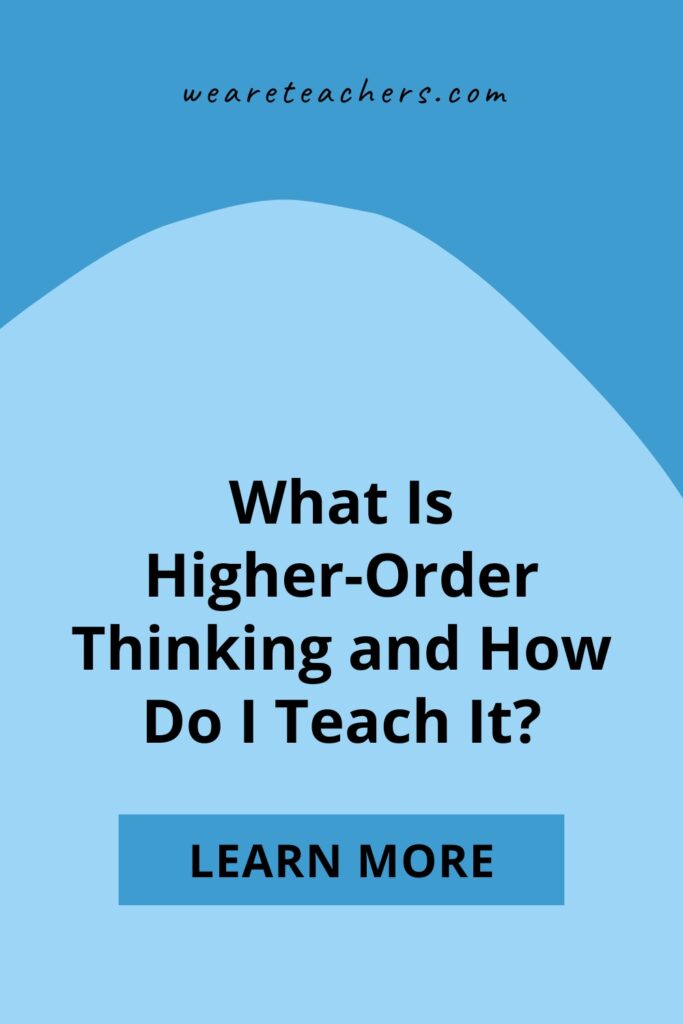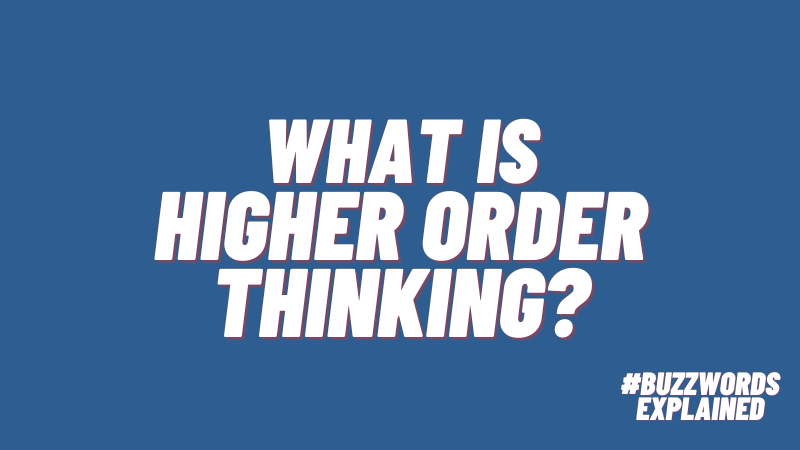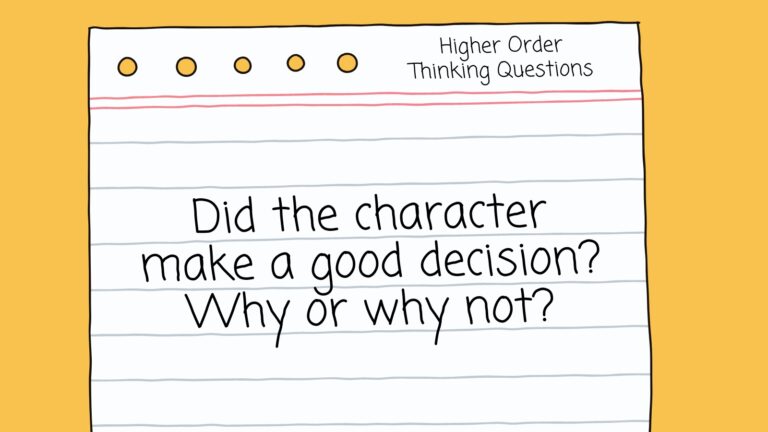Educators know that people learn in a variety of ways and that we often learn best when we can make connections to the material on a deeper level. That’s why higher-order thinking is such a valuable skill, one that serves students well throughout their school years and beyond. But what exactly does the term mean? And how can teachers build higher-order thinking skills in their students? Learn what you need to know here.
What is higher-order thinking?

Source: Vanderbilt University
Higher-order thinking refers to the top levels of cognitive thinking, as laid out in the Bloom’s Taxonomy model. When we use higher-order thinking, we push beyond basic memorization and recall to analyze and synthesize information. These are the skills that help us evaluate information and think critically. We also use these skills to develop new ideas and concepts, building on previous knowledge to create something entirely new.
Bloom’s Taxonomy
Benjamin Bloom headed a team of educational researchers in the 1950s and led the development of the model that bears his name today. He and his team broke cognitive thinking into six levels, shown as a pyramid. The bottom levels provide the foundation for the higher-order thinking skills at the top.
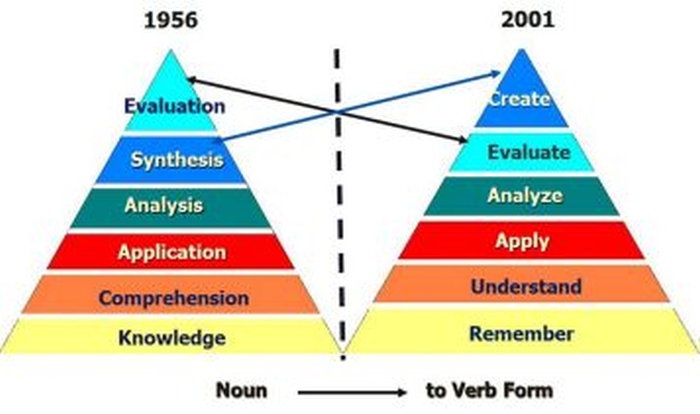
Source: Revised Bloom’s Taxonomy/University of Michigan
If you first learned about Bloom’s Taxonomy more than 20 years ago, it looked a little bit different. In 2001, education experts decided to revise the taxonomy to make it more accurate and easier for educators to understand and apply. They changed the category names from nouns to verbs, showing the action learners would take for each. And they determined that the top two tiers should actually be switched, making “Create” (Synthesis) the highest order of thinking.
Learn more about the history and development of Bloom’s Taxonomy here.
What are the Lower-Order Thinking Skills (LOTS)?

Source: Lower-Order Thinking Skills/Helpful Professor
The bottom three levels of Bloom’s Taxonomy are referred to as the Lower-Order Thinking Skills (LOTS). It’s important to note that even though these skills are considered lower on the pyramid, they’re still extremely important. Think of these as the foundational skills students must have to support their higher-order thinking.
Remember
These are skills like memorizing math facts, defining vocabulary words, or knowing the main characters and basic plot points of a story. This is the kind of information you can check using flash cards, spelling tests, true/false questions, and more. There are many basic facts that kids must master so they can quickly recall them as needed.
Check out 21 Ways To Build Background Knowledge to learn more.
Understand
When you understand a concept, you can explain how it works to someone else. True understanding is more than memorization or reciting facts. It’s the difference between a child reciting by rote “one times four is four, two times four is eight, three times four is twelve,” versus recognizing that multiplication is the same as adding a number to itself a certain number of times. This is why we often ask students to “show their work” or “show their thinking” on math tests.
See 20 Ways To Check for Understanding for more information.
Apply
When you apply your knowledge, you take a concept you’ve already mastered and apply it to new situations. For instance, a student learning to read doesn’t need to memorize every word. Instead, they use their skills in sounding out letters to tackle each new word as they come across it.
Explore 25 Easy Ways To Make Math Practice Fun here.
Which levels constitute higher-order thinking skills (HOTS)?

Source: Higher-Order Thinking Skills/Helpful Professor
The top three levels make up the Higher-Order Thinking Skills (HOTS), also known as critical thinking skills. When students use these skills, they delve deeper into information. Rather than simply accepting facts, they explore the reasons behind them and make cause-and-effect connections. They evaluate the validity of facts and use them to synthesize new concepts, ideas, and inventions.
Analyze
When we analyze something, we don’t take it at face value. Analysis requires us to find facts that stand up to inquiry. We put aside personal feelings or beliefs, and instead identify and scrutinize primary sources for information. This is a complex skill, one we hone throughout our entire lives. When students compare and contrast multiple concepts, sort and categorize, or ask “why” questions, they’re analyzing.
Try these 25 Cause-and-Effect Lesson Plans and Activities to help kids analyze information.
Evaluate
Evaluating means reflecting on analyzed information, selecting the most relevant and reliable facts to help us make choices or form opinions. True evaluation requires us to put aside our own biases and accept that there may be other valid points of view, even if we don’t necessarily agree with them. Students evaluate when they debate topics, write persuasive essays, assess their own or others’ writings, and more.
Use these 35 Strong Persuasive Writing Examples to show students how evaluation works in practice.
Create
At the highest level, students take the facts that they’ve mastered, evaluated, and analyzed, and use them to create something entirely new. This might be designing a science experiment, building a computer program, writing a paper putting forth new ideas, authoring a story or making art, and other creative activities.
Discover 40 Ways To Make More Time for Creativity in Your Lesson Plans.
Why is it so important to teach higher-order thinking?
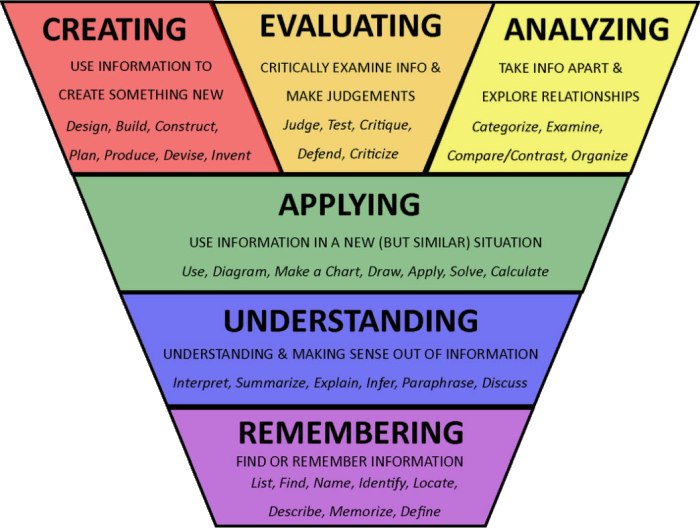
Source: Equal Levels/University of Michigan
While remembering, understanding, and applying are key skills, they don’t really develop students into lifelong learners and critical thinkers. As kids often point out, if they need to know the date of the start of the American Civil War or the third law of motion, they can just look it up in a book or online.
What really matters is what we do with the information we have. Higher-order skills are the ones people use in daily life to make informed decisions and create new products and processes. They help us think critically, something that’s incredibly vital in this age of constant information overload.
When we teach higher-order thinking skills, we give students the ability to solve problems, develop creative solutions, make smart choices, and evaluate the validity of information. Kids grow into adults who understand how to think carefully about the world and feel confident enough to share their own ideas, concepts, and creations with others.
Read more about the importance of higher-order thinking here.
How do I teach higher-order thinking?
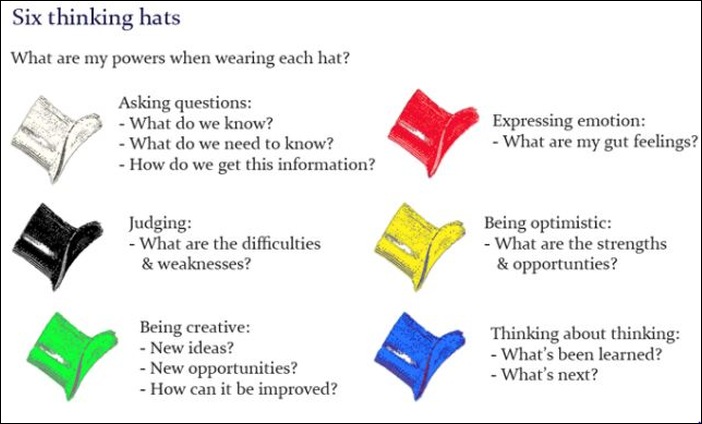
Source: The IDEA Lab
There are a multitude of ways to encourage higher-order thinking in your students. While some say that kids don’t really begin to develop these skills until upper elementary, others argue that it’s never too soon to challenge kids to make connections and ask questions. You can tweak these quick higher-order thinking strategies to work in any classroom, no matter the age or subject.
1. Ask higher-order thinking questions.
Keep a list of higher-order thinking questions on hand, and use them regularly in class. Consider making a bulletin board or anchor chart with some of your favorites, and refer kids to it as they learn. Get a huge list of higher-order thinking questions here.
2. Encourage discussion and debate
When kids learn to disagree respectfully and argue their own opinions using facts to back their beliefs, they’re preparing to take part in the discourse of the world at large. Encourage those with conflicting points of view to share them in your classroom, and teach kids how to analyze and evaluate those points though discussion and debate. Try these resources:
- 60 Funny Debate Topics for Kids of All Ages
- 100 Winning Debate Topics for Middle School Students
- 100 High School Debate Topics To Engage Every Student
- 110+ Controversial Debate Topics to Challenge Your Students
- 60 Interesting Persuasive Essay Topics for Kids and Teens
3. Try STEM challenges.
STEM challenges encourage kids to come up with their own unique answers to problems. They use their knowledge and understanding of science, technology, engineering, and math to analyze and evaluate the challenge and create new solutions. Start with these 50 STEM Activities To Help Kids Think Outside the Box. Then, visit our archive of STEM challenges and science experiments for ideas.
4. Use graphic organizers.
Graphic organizers are tools that let kids make connections, create a plan, and communicate effectively. A good organizer simplifies complex information and lays it out in a way that makes it easier for a learner to digest. Graphic organizers may include text and images, depending on the purpose and student’s learning style. Read all about graphic organizers and learn how to use them here.
5. Incorporate project-based learning.
Project-based learning uses HOTS like analysis and evaluation, collaboration and communication, and problem-solving. As students conduct their hands-on projects, they dig deeper into a real-world topic and make personal connections to the knowledge and skills they’re gaining. In many ways, PBL is more like the work adults do in their daily jobs, especially because students collaborate with others outside their school community. Discover the basics of project-based learning here, then check out 55+ Real-World Project-Based Learning Ideas for All Ages and Interests.
Have more questions about higher-order thinking? Come talk it over with other educators in the WeAreTeachers HELPLINE group on Facebook.
Plus, What Is Critical Thinking and Why Do We Need To Teach It?
